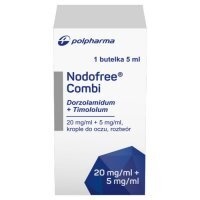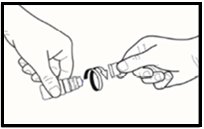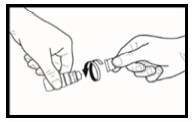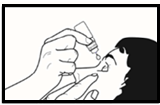

Nodofree Combi

Ask a doctor about a prescription for Nodofree Combi

How to use Nodofree Combi
Leaflet attached to the packaging: information for the user
Nodofree Combi, 20 mg/ml + 5 mg/ml, eye drops, solution
Dorzolamide + Timolol
You should carefully read the contents of the leaflet before using the medicine, as it contains important information for the patient.
- You should keep this leaflet, so that you can read it again if you need to.
- If you have any doubts, you should consult a doctor or pharmacist.
- This medicine has been prescribed specifically for you. Do not pass it on to others. The medicine may harm another person, even if their symptoms are the same.
- If the patient experiences any side effects, including any side effects not listed in this leaflet, they should tell their doctor or pharmacist. See section 4.
Table of contents of the leaflet
- 1. What is Nodofree Combi and what is it used for
- 2. Important information before using Nodofree Combi
- 3. How to use Nodofree Combi
- 4. Possible side effects
- 5. How to store Nodofree Combi
- 6. Contents of the packaging and other information
1. What is Nodofree Combi and what is it used for
Nodofree Combi is an ophthalmic medicine in the form of sterile eye drops without preservatives, containing two active substances: dorzolamide and timolol.
- Dorzolamide belongs to a group of medicines called "carbonic anhydrase inhibitors".
- Timolol belongs to a group of medicines called "beta-adrenergic receptor inhibitors" (beta-adrenolytics). These medicines together cause a decrease in intraocular pressure through two different mechanisms.
Nodofree Combi is recommended for the treatment of glaucoma to reduce elevated intraocular pressure, when the use of eye drops containing only a beta-adrenergic receptor inhibitor is not sufficient.
2. Important information before using Nodofree Combi
When not to use Nodofree Combi
- if the patient is allergic to dorzolamide hydrochloride, timolol maleate or any of the other ingredients of this medicine (listed in section 6);
- if the patient currently or in the past has had respiratory system disorders, such as asthma or severe chronic obstructive pulmonary disease (a serious lung disease that can cause wheezing, breathing difficulties and/or prolonged cough);
- if the patient has a slow heart rate, heart failure or heart rhythm disorders (irregular heartbeat);
- if the patient has severe kidney disease or severe kidney function disorders or a history of kidney stones;
- if the patient has excessive acidification of the blood due to the accumulation of chloride ions in the body (hyperchloremic acidosis).
In case of doubts about whether Nodofree Combi can be used, you should consult a doctor or pharmacist.
Warnings and precautions
Before starting to use Nodofree Combi, you should discuss it with your doctor.
You should inform your doctor about all current or past eye disorders and diseases, especially if you have:
- ischemic heart disease (its symptoms include, among others, chest pain or a feeling of pressure in the chest, shortness of breath or a feeling of suffocation);
- heart rhythm disorders, such as slow heart rate;
- breathing difficulties, asthma or chronic obstructive pulmonary disease;
- diseases related to poor blood circulation (such as Raynaud's disease or Raynaud's syndrome);
- diabetes, as timolol may mask the objective and subjective symptoms of hypoglycemia (low blood sugar);
- hyperthyroidism, as timolol may mask its objective and subjective symptoms;
Before surgery, you should inform your doctor about the use of Nodofree Combi, as timolol may change the effect of some anesthetics. You should also tell your doctor about any allergies to medicines or anaphylactic reactions.
You should inform your doctor if you have muscle weakness or have been diagnosed with myasthenia.
If you experience eye irritation or any new eye problems, such as eye redness or eyelid swelling, you should see a doctor immediately.
If you suspect that Nodofree Combi is causing an allergic reaction or hypersensitivity (e.g. skin rash, severe skin reaction or skin redness and eye itching), you should stop using this medicine and contact your doctor immediately.
You should inform your doctor in case of eye infection, eye injury, after eye surgery or if you experience a reaction accompanied by the appearance of new or worsening of existing symptoms.
After administration to the eye, Nodofree Combi may cause systemic effects.
No studies have been conducted on the use of Nodofree Combi in patients using contact lenses. Before using Nodofree Combi, people using soft contact lenses should consult a doctor. Before administering the medicine, contact lenses should be removed and put back on at least 15 minutes after administration.
Use in children
Experiences with the use of dorzolamide hydrochloride with timolol maleate (in a form with a preservative) in infants and children are limited.
Use in the elderly
In studies using dorzolamide hydrochloride with timolol maleate (in a form with a preservative), similar effects were observed in elderly and younger patients.
Use in patients with liver function disorders
You should inform your doctor about any current or past liver diseases.
Nodofree Combi and other medicines
Nodofree Combi may affect the action of other medicines or other medicines used by the patient may affect the action of Nodofree Combi. This also applies to other anti-glaucoma eye medicines. You should tell your doctor about taking or planning to take blood pressure-lowering medicines, heart medicines or anti-diabetic medicines. You should tell your doctor or pharmacist about all medicines you are currently taking or have recently taken, as well as any medicines you plan to take. This is especially important in the case of:
- taking blood pressure-lowering medicines or medicines used for heart diseases (such as calcium channel blockers, beta-adrenergic receptor blockers or digoxin);
- taking medicines used for heart rhythm disorders or restoring a regular heart rhythm (such as calcium channel blockers, beta-adrenergic receptor blockers or digoxin);
- taking other eye drops containing beta-adrenolytics;
- taking other carbonic anhydrase inhibitors, such as acetazolamide;
- taking monoamine oxidase inhibitors (MAOIs);
- taking medicines with a parasympathomimetic (cholinergic) effect, which may be used for urinary disorders. Parasympathomimetic medicines are also sometimes used to restore normal motility (mobility) of the intestines;
- taking opioids, such as morphine, used to treat moderate to severe pain;
- taking anti-diabetic medicines;
- taking antidepressants, such as fluoxetine and paroxetine;
- taking chemotherapeutic agents from the sulfonamide group;
- taking quinidine (a medicine used to treat heart diseases and certain forms of malaria).
Pregnancy and breastfeeding
If you are pregnant or breastfeeding, think you may be pregnant or plan to have a child, you should consult a doctor or pharmacist before using this medicine.
Use during pregnancy
Nodofree Combi should not be used during pregnancy.
Use during breastfeeding
Nodofree Combi should not be used during breastfeeding. Timolol may pass into breast milk. Before taking any medicine during breastfeeding, you should consult your doctor.
Driving and using machines
No studies have been conducted on the effect on the ability to drive vehicles or operate machinery. Some side effects related to the use of Nodofree Combi, such as blurred vision, may affect the ability to drive vehicles and/or operate machinery. Patients who feel unwell or have blurred vision should not drive vehicles or operate machinery until these symptoms have resolved.
3. How to use Nodofree Combi
This medicine should always be used as directed by your doctor. If you have any doubts, you should consult a doctor or pharmacist.
Your doctor will determine the correct dose of the medicine and the duration of treatment.
The recommended dose is one drop into the affected eye(s) in the morning and evening.
If, in addition to Nodofree Combi, other eye drops are used at the same time, a minimum of 10 minutes should be allowed between administration of the next medicine. Eye ointments should be used last.
The dose of the medicine should not be changed without consulting a doctor.
If you have difficulty using the drops, you should ask a family member or caregiver for help.
Nodofree Combi is a sterile solution that does not contain preservatives. See section 6
- What Nodofree Combi looks like and what the packaging contains
Do not allow any part of the bottle to touch the eye or its surroundings. This may lead to eye damage and contamination with bacteria that can cause eye infection leading to serious damage or even vision loss. To avoid possible contamination of the bottle, you should wash your hands before using this medicine and avoid touching the tip of the dropper with any surface.
Before administering the eye drops:
- In case of first use, before administering the drops to the eye, the patient should try using the bottle with the dropper by slowly squeezing it until one drop is released from the bottle, away from the eye.
- If the patient is sure they can administer a single drop, they should take the most comfortable position for administration (they can sit, lie on their back or stand in front of a mirror).
Instructions for use:
- 1. Before administering the medicine, the patient should wash their hands thoroughly.
- 2. If the packaging or bottle is damaged, the medicine should not be used.
- 3. Before using the drops for the first time, the patient should unscrew the cap after making sure that the guarantee ring on the cap is intact. When unscrewing, the patient will feel slight resistance until the ring breaks ( see figure 1.).
- 4. If the guarantee ring is loose, it should be removed before using the medicine, as it may fall into the eye and cause damage.
- 5. The patient should tilt their head back and then gently pull the lower eyelid down with their finger, creating a "pocket" between the eyeball and the eyelid ( see figure 2.). (You should avoid touching the tip of the dropper with the eye, eyelids or fingers.)
- 6. One drop should be administered by slowly squeezing the bottle. The bottle should be gently squeezed in the middle, so that the drop gets into the patient's eye. Remember that there may be a few seconds' delay between squeezing the bottle and releasing the drop. The patient should not squeeze the bottle too hard ( see figure 3.). The patient should be informed to consult a doctor, pharmacist or nurse in case of any doubts about using the medicine.
- 7. The eye should be closed and the inner corner of the eye should be pressed with a finger for about two minutes. This helps prevent the medicine from entering the entire body.
- 8. You should avoid touching the tip of the dropper with the eye, eyelids or fingers.
- 9. If the doctor recommends using drops in the other eye, steps 5, 6 and 7 should be repeated.
- 10. After use and before closing the bottle, the bottle should be shaken downwards without touching the tip of the dropper to remove any remaining liquid from the tip of the dropper. This is necessary to ensure the possibility of administering subsequent drops. Immediately after use, the bottle should be tightly closed ( see figure
- 4.). If the drop does not get into the eye, the attempt to administer the drop should be repeated.




Figure 1.
Figure 2.
Figure 3.
Figure 4.
Using a higher dose of Nodofree Combi than recommended
In case of administration of too many drops to the eye or ingestion of the contents of the bottle, dizziness, breathing difficulties or a feeling of slow heart rate may occur. You should contact a doctor immediately.
Missing a dose of Nodofree Combi
Nodofree Combi should be used as directed by your doctor.
If a dose of the medicine is missed, it should be used as soon as possible. However, if it is almost time for the next dose, the missed dose should not be used and the regular dosing schedule should be resumed.
A double dose should not be used to make up for a missed dose.
Stopping the use of Nodofree Combi
Before stopping the medicine, you should consult a doctor.
In case of any further doubts about using the medicine, you should consult a doctor or pharmacist.
4. Possible side effects
Like all medicines, this medicine can cause side effects, although not everybody gets them.
Side effects:
If you experience any of the following side effects, you should stop using this medicine and seek medical help immediately, as they may be symptoms of a reaction to the medicine.
Generalized allergic reactions, including swelling under the skin, may occur in the face and limbs and cause respiratory tract obstruction and swallowing difficulties, shortness of breath, hives or itchy rash, local and generalized rash, itching and severe, sudden and life-threatening allergic reaction.
Eye drop treatment can usually be continued, unless the side effects are severe. If you have concerns, you should consult a doctor or pharmacist. You should not stop using Nodofree Combi without consulting a doctor.
During clinical trials or after the medicine was placed on the market, the following side effects were reported in relation to dorzolamide hydrochloride and timolol maleate (in a form without preservatives) or after using one of the active substances:
Very common (occurring in more than 1 in 10 patients):
- feeling of burning and stinging in the eye, change in taste sensation.
Common (occurring in less than 1 in 10 patients):
- redness of the eyeballs and skin around the eye (eyes), tearing or itching of the eye (eyes), corneal ulcers (damage to the front layer of the eyeball), swelling and/or irritation of the eyeballs and skin around the eye (eyes), feeling of a foreign body in the eye, decreased sensitivity of the cornea (not feeling a foreign body in the eye and not feeling pain), eye pain, dry eyes, blurred vision, headache, sinusitis (feeling of tension or fullness in the nose), nausea, weakness and feeling of fatigue.
Uncommon (occurring in less than 1 in 100 patients):
- dizziness, depression, uveitis, vision disorders, including changes in refraction (in some cases due to the withdrawal of pupil-constricting medicines), slow heart rate, fainting, shortness of breath, indigestion, kidney stones.
Rare (occurring in less than 1 in 1000 patients):
- systemic lupus erythematosus (an autoimmune disease that can cause inflammation of internal organs) ,tingling or numbness of hands or feet, insomnia, nightmares, memory loss, worsening of myasthenia symptoms (muscle disorder), decreased sex drive, stroke, transient myopia, which may resolve after discontinuation of the medicine, detachment of the layer under the retina, which can cause vision disorders, drooping eyelids (eyelids are half-closed), double vision, formation of crusts on the eyelids, corneal edema (with subjective symptoms of vision disorders), low eye pressure, ringing in the ears, low blood pressure, heart rhythm disorders (changes in heart rhythm or rate), congestive heart failure (heart disease characterized by shortness of breath and swelling of the feet and legs due to fluid accumulation), edema (fluid accumulation), palpitations (fast and/or irregular heartbeat), cerebral ischemia (reduced blood flow to the brain), chest pain, strong heartbeat, which can be fast or irregular (palpitations), myocardial infarction, Raynaud's phenomenon, swelling of hands and feet or cold hands and feet and poor circulation in the upper and lower limbs, muscle cramps in the legs and/or leg pain when walking (intermittent claudication), shortness of breath, respiratory failure, rhinitis (runny nose), nosebleeds, bronchospasm, cough, throat irritation, dry mouth, contact dermatitis, hair loss, white-silver rash (psoriasis-like rash), Peyronie's disease (which can cause penis curvature), allergic reactions, such as rash, hives, itching, and in rare cases, lip swelling, eyelid swelling and mouth swelling, wheezing or severe skin reactions (Stevens-Johnson syndrome, toxic epidermal necrolysis).
As with other locally administered eye medicines, timolol is absorbed into the bloodstream, which can cause side effects similar to those observed after oral administration of beta-adrenergic receptor blockers. Side effects occur less frequently after local administration of eye drops than after oral administration or injections of these medicines.
Among the listed additional side effects, reactions typical of the therapeutic group of beta-adrenergic medicines used for ophthalmic disorders are included:
Unknown (frequency cannot be determined based on available data):
low blood sugar, heart failure, heart rhythm disorders, abdominal pain, vomiting, muscle pain unrelated to physical exertion, sexual function disorders, hallucinations and feeling of a foreign body in the eye (feeling that something is in the eye), rapid heartbeat, increased blood pressure.
Reporting side effects
If you experience any side effects, including any side effects not listed in this leaflet, you should tell your doctor or pharmacist. Side effects can be reported directly to the Department of Adverse Reaction Monitoring of Medicinal Products, Medical Devices and Biocidal Products, Al. Jerozolimskie 181C, 02-222 Warsaw, Tel.: +48 22 49 21 301, Fax: +48 22 49 21 309, website: https://smz.ezdrowie.gov.pl
Side effects can also be reported to the marketing authorization holder.
By reporting side effects, you can help gather more information on the safety of the medicine.
5. How to store Nodofree Combi
Store at a temperature below 30°C.
After opening the bottle for the first time - store for 90 days at a temperature below 25°C.
This medicine should be stored out of sight and reach of children.
Do not use this medicine after the expiry date stated on the label and carton.
The expiry date stated on the label and carton is the last day of the specified month.
The inscription on the packaging after the abbreviation "EXP" means the expiry date, and after the abbreviation "Lot" means the batch number.
Medicines should not be disposed of via wastewater or household waste. You should ask your pharmacist how to dispose of medicines that are no longer needed. This will help protect the environment.
6. Contents of the packaging and other information
What Nodofree Combi contains
- The active substances of the medicine are dorzolamide and timolol. Each ml contains 20 mg of dorzolamide (in the form of dorzolamide hydrochloride 22.26 mg) and 5 mg of timolol (in the form of timolol maleate 6.83 mg). Each drop (about 35 µl) contains 0.70 mg of dorzolamide and 0.18 mg of timolol.
- The other ingredients are: hydroxyethylcellulose 6400-11900 mPa·s, mannitol, sodium citrate, sodium hydroxide (to adjust pH), water for injections.
What Nodofree Combi looks like and what the packaging contains
Nodofree Combi is a clear, colorless, slightly viscous solution.
The medicine is available in white 5 ml bottles (LDPE), with a multi-dose dropper (HDPE) that prevents contamination of the solution with bacteria thanks to a system consisting of a silicone membrane and air filtration entering the bottle, with an HDPE cap with a guarantee seal, in a cardboard box.
Packaging:
1 x 5 ml
3 x 5 ml
Not all pack sizes may be marketed.
Marketing authorization holder
Pharmaceutical Works POLPHARMA S.A.
Pelplińska 19, 83-200 Starogard Gdański
tel. +48 22 364 61 01
Manufacturer
Rafarm S.A.
Thesi Pousi Xatzi Agiou Louka
Paiania, 190 02
Greece
Date of last revision of the leaflet:February 2024
- Country of registration
- Active substance
- Prescription requiredYes
- ImporterRafarm S.A.
- This information is for reference only and does not constitute medical advice. Always consult a licensed doctor before taking any medication. Oladoctor is not responsible for medical decisions based on this content.
- Alternatives to Nodofree CombiDosage form: Drops, 50 mcg/ml + 5 mg/mlActive substance: timolol, combinationsManufacturer: Pharmaselect International Beteiligungs GmbHPrescription not requiredDosage form: Drops, (0.3 mg + 5 mg)/mlActive substance: timolol, combinationsPrescription requiredDosage form: Drops, 0.3 mg/ml + 5 mg/mlActive substance: timolol, combinationsManufacturer: Genetic S.p.APrescription required
Alternatives to Nodofree Combi in other countries
The best alternatives with the same active ingredient and therapeutic effect.
Alternative to Nodofree Combi in Spain
Alternative to Nodofree Combi in Ukraine
Online doctors for Nodofree Combi
Discuss dosage, side effects, interactions, contraindications, and prescription renewal for Nodofree Combi – subject to medical assessment and local rules.














